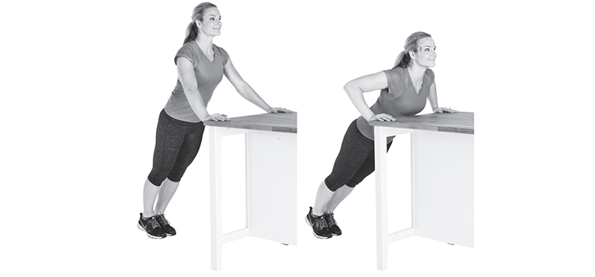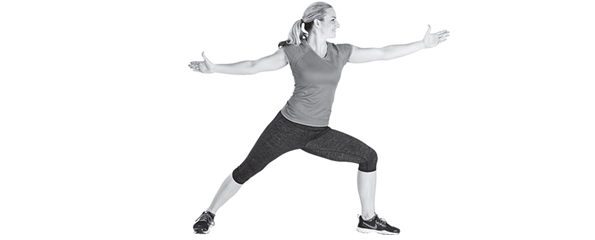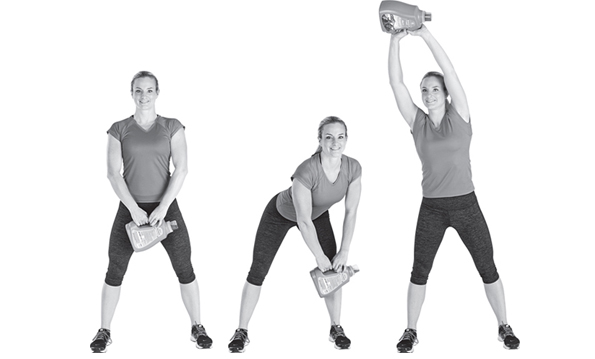Lose the Clutter, Lose the Weight (36 page)
Read Lose the Clutter, Lose the Weight Online
Authors: Peter Walsh
Wall Pushups
To do pushups against a wall, countertop, desk, or stair, stand with your feet several feet away from the object. Place your hands on the object a bit wider than shoulder width. Lower your chest as far as you can toward the object while holding your body straight (in other words, your rear shouldn't be sticking out or sagging down). Press your body back up away from the object. Repeat as necessary.

Warrior 2 Pose
Step forward with your left foot into a deep lunge. Your left knee should not extend past your left toes. Your right leg should be extended behind you, with your toes pointed out toward the right.
Now turn your hips and shoulders so your body is facing the right. Extend your arms widely so that your left arm is extended out over your left knee and your right arm is extended over your right leg. Your hands should be open and your palms facing out. You should be looking down your left arm, and your right leg should be straight and extended in the opposite direction of your left leg. Hold the pose for 5 to 15 seconds and repeat two or three times or as necessary.

Woodchoppers
Stand with your toes pointed forward, your feet spaced about shoulder-width apart, and your knees slightly bent. With both hands, grasp a weighted object with a handleâsuch as a large Thermos filled with liquidâand extend your arms downward so you're holding the object over your left thigh.
Keeping your arms extended, lift the object up and across your body so you end up holding it over and to the right of your right shoulder. Keep your abdominal muscles tight throughout the movement. Repeat as necessary before switching and performing the exercise on the other side.

Part 3
The Six-Week Program Begins
Chapter 8
MAKE EACH WEEK A SUCCESS
T
hough the
Lose the Clutter, Lose the Weight
program is a 6-week activity, in a sense you can also look at it as
1
week's worth of effort that you repeat and expand upon six times.
Each week, you'll engage in a flurry of decluttering activity in a new room or area of your home while following a similar series of steps. Before you begin, I wanted to offer some quick pointers that can help you succeed from the first week to the last and beyond.
Your Blueprint for Each Room
When you prepare to declutter each new part of your home, I understand how daunting the challenge may seem. I've ventured into rooms where I could only see some ceiling, a little of the floor, and none of the wall space. But you could eat an elephant if you had to, and you can do this, too.
Here's how to tackle each area:
Create a vision.
We are all programmed to focus on what we want “for” everything. “What do you want
for
your birthday?” “What should we eat
for
dinner?” “What furniture do I want
for
my living room?”
What's wrong with this approach?
 It almost always leads you to buy something. You're buying something that you hope will bring you happiness or show that you're feeling love and concern.
It almost always leads you to buy something. You're buying something that you hope will bring you happiness or show that you're feeling love and concern.
 It too often focuses on how you can serve objectsâ“How can I give this room what it needs?”ârather than how objects should serve you.
It too often focuses on how you can serve objectsâ“How can I give this room what it needs?”ârather than how objects should serve you.
The word “for” takes you the wrong way. Instead, start with the word “from.”
“What do you want
from
your birthday?” (In other words, how do you want to feel at the end of the day?) “What do we want
from
breakfast?” “What do I want
from
my living room?” By framing the question this way with each new room of your house, you describe your vision for the space.
Your vision is your starting point for decluttering the room. This vision sums up how you want the room to suit your needs, what emotion you want the space to evoke, and how you'll feel once the room is doing its job.
It's easy to say, “I want a painting
for
my bedroom” and to find one that's suitable. It's more challenging to say, “I want peace and calm, romance and tranquility
from
my master bedroom” and then work to create that mood in your space.
But doing this first will help you declutter the room more efficientlyâand enjoy better results for the effort you put into it.
Follow a list of tasks.
How do you eat that elephant? One bite at a time. Each week, I've provided a list of tasks that take you through each room in a deliberate manner. Some rooms require more tasks than others. Some tasks are easy, some take more time and labor.
At the beginning of each week, I'd recommend that you scan the list of tasks and figure out how to divide them evenly over the week so you have enough time for each.
Give yourself plenty of time.
You're losing weight and making your home livable again. These are not trivial undertakings. They're huge improvements of utmost importance. Give these activities the time and focus they deserve.
Plan your day around how you'll eat and when you'll do your decluttering tasks. Keep your kitchen stocked with foods on your meal plan so you never order a pizza because your cupboard is empty. Schedule everything else around this program rather than squeezing in the program when you have a few spare minutes.
It's quite possible that after the first 6 weeks, the changes you've made will become second nature, and sticking with them won't require so much time and attention.
Set Yourself Up for Success
A few more steps will help you savor your successes and leap over obstacles when you encounter them.
Remember that it's not just about the decluttering.
Be sure not to forget to make time for exercise throughout the week. Stick with it so your body becomes ready for the increasing physical challenges as you progress through the program.
Take photos.
Before you start on each area, take a picture of it. By looking at a picture of the clutter, you can view your rooms from another, more detached and less emotional perspective.
Afterward, you'll be able to enjoy your new room even more once you take an “after” photo to do a side-by-side comparison. Down the road when you're in the post-program maintenance phase, you'll also have photographic reminders of how you never want your home to look again.
While you have your camera out, consider taking pictures of mementos that you're going to haul out. Letting go of things is often easier if you have photos that preserve the memory of them.
Get support.
The participants on the test panel weren't just keeping in touch with me during the programâthey were also supporting each other via a social-media group. Afterward, many of them told me how much the encouragement from the other participants helped them.
Be sure to line up your own forms of support and create ways to broadcast your success (if you enjoy sharing these sorts of events, of course). You might:
 Get on Facebook, put your before-and-after pictures on Twitter, or take to the social-media site of your choice. I have a Facebook page with more than 65,000 creative and encouraging followers. If you're stuck on a problem or you feel like celebrating, someone is likely to offer an answer or share your happy moment with you. (I'm often part of these online conversations, too!)
Get on Facebook, put your before-and-after pictures on Twitter, or take to the social-media site of your choice. I have a Facebook page with more than 65,000 creative and encouraging followers. If you're stuck on a problem or you feel like celebrating, someone is likely to offer an answer or share your happy moment with you. (I'm often part of these online conversations, too!)